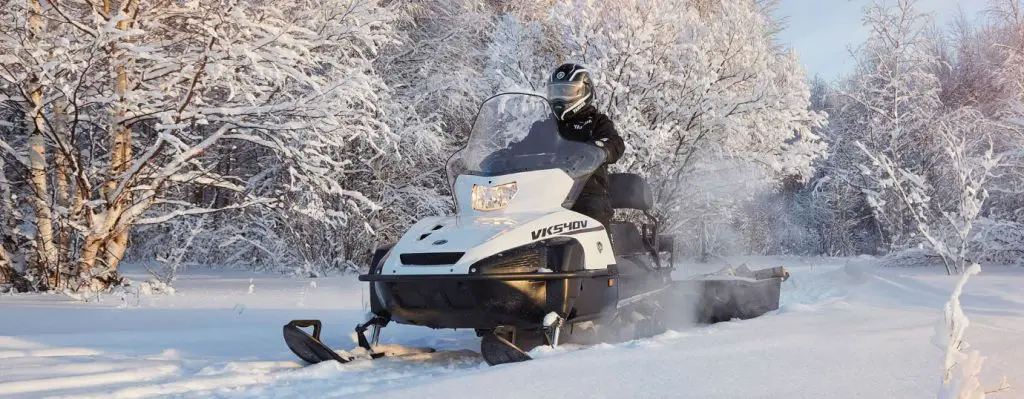
The holiday season is here and there has already been decent snowfall in quite a few regions. The festive spirit of the holidays and the fresh cover of snow pumps the adrenaline of snowmobile riders like nothing else. However, at the same time, it is essential to emphasize snowmobile safety.
Table of Contents
The Need For Snowmobile Safety
There has been an increase in the number of snowmobile-related accidents and fatal crashes in the past few years. Safety is not only important for the snowmobile riders but also for the people around them.
Common snowmobile crashes involve stationary objects like trees and poles, another snowmobile, or motorized vehicles. There have been cases wherein an out of control snowmobile has hit walking or standing persons. Sometimes, a snowmobile can roll over or break through thin ice. Unfortunately, some accidents result in hypothermia or drowning. A few people have also injured themselves while loading and unloading snowmobiles from trucks.
The loud noise from snowmobiles and helmets impact the hearing capability of the rider. It is harder for them to judge their surroundings using their hears. Therefore, riders need to be more alert and rely on their vision and judgment. These hazards posed by snowmobiles emphasize the need for safety.
How To Stay Safe On Snowmobiles
While people have the right to enjoy their passion, they also have the duty to ensure the safety of others and themselves. Here are a few ways that you can enhance snowmobile safety.
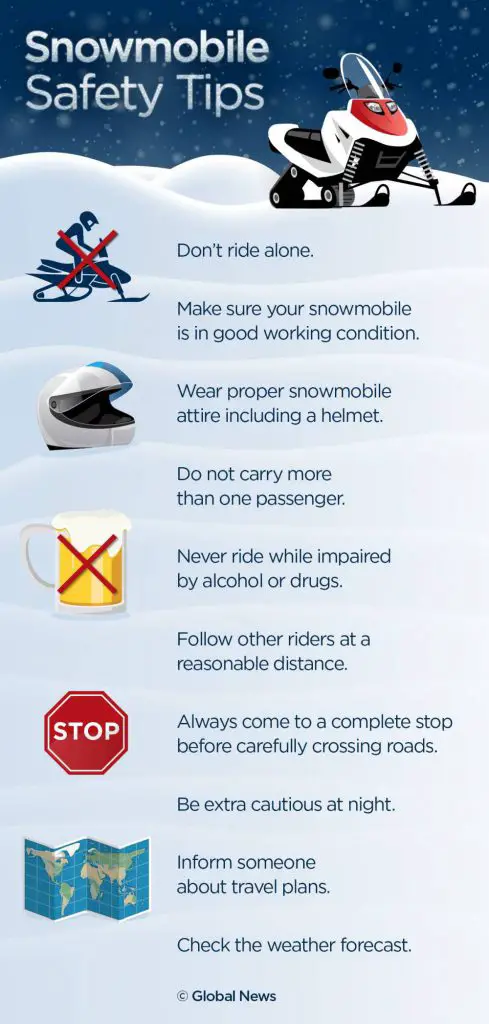
Enroll In A Snowmobile Safety Course
Enrolling in a snowmobile safety course is the first step that you can take towards snowmobile safety. All states require that the riders born after a certain date must obtain a snowmobile safety certification. They must complete a course for the same. These courses teach the riders about the laws, operation, and snowmobile safety. Most states have departments that provide both online and traditional classroom courses. Riders can enroll in either course for obtaining their certification.
There are separate courses available for Youth (for 11-15 years old) and Adult (16+ years old) certifications. Parents who want to teach their children to ride can enroll them in a Youth snowmobile safety certification course. The fee charged for these courses is nominal and they can be completed in a few days. It makes snowmobile riders aware of different rules and regulations regarding snowmobiles while teaching them how to avoid accidents. A performance review course is also undertaken to test the skills of a snowmobile rider. Any youth or adult who is new to snowmobile riding or does not have a certification can enroll in a snowmobile safety course.
Follow The Rules And Drive Safe
Knowing the rules and regulations regarding snowmobiles is not adequate. You must consciously follow these rules at all times for snowmobile safety. Individuals often overlook rules, safeguards, and precautions when they are riding a snowmobile. The adrenaline rush that you experience when riding a snowmobile can lead you to disregard the rules. You should make a conscious effort to follow the recommendations at all times. Drive under the specified speed limits, use indicators, and take proper precautions when turning or changing lanes.
If you are going to use a snowmobile for towing, then consider buying an appropriate sled attached properly to the snowmobile. Don’t use makeshift items such as tubes or skis to pull people or goods. When towing, drive the snowmobile at a gentle speed. Avoid overloading your snowmobile as it can affect its handling. States may have specific rules and regulations for snowmobile riders. Make yourself aware of them and follow them.
Expect the worst from other snowmobile riders and be a defensive driver. Focus on self-preservation and ensure your and others’ safety.
Wear The Right Snowmobile Gear and Apparel
Wearing the right gear and apparel is an important aspect of snowmobile safety. There are many different items and clothing you require for riding in the snow. They keep you warm while also shielding you from any physical harm. The essential snowmobiling items include a helmet, gloves, goggles, socks, boots, and a snowmobile suit (or jacket and bibs). The gear or apparel you buy should be suitable for the climate you are going to ride in. Avoid apparel made from cotton as it absorbs moisture and will freeze if it gets wet.
- Helmet – A snowmobile helmet protects your head from cold, snow, and icy winds as well as in case of accidents or crashes. Consider a DOT-approved helmet that fits you perfectly. There are heated helmets also available for riding in extremely cold conditions. They prevent the helmet from fogging and blocking your vision.
- Gloves and Socks – Gloves and socks are important for shielding the hands from the cold. If your hands or feet are cold and stiff due to unsuitable gloves or socks, then you may not have complete control over your snowmobile, which can lead to accidents. You can consider heated gloves and socks for riding in sub-zero weather conditions. Mittens are warmer than gloves and more suited for cold conditions.
- Goggles – Goggles are another item on the list of snowmobile safety gear. They protect your eyes from icy winds and snow while enhancing your vision. They are important if you don’t have a full-face helmet. Snow blindness is a common cause of accidents and having good-quality goggles with UV protection can minimize the chances of the same.
- Snowmobile Suit – Your snowmobile suit should be waterproof and well-insulated for protecting you from the cold conditions. Inappropriate clothing items not only make you feel uncomfortable but can also cause frostbites and hypothermia, which can be life-threatening. Make sure that the suit is made from materials like polyester blends that wick away moisture and are windproof. It should also have sufficient insulation for keeping you warm. You can wear layers of insulating clothes underneath the snowsuit if required.
Wearing the snowmobile gear is as important as owning it. Even if you are going to ride close by or to your neighbor’s house, spend a few minutes to safeguard yourself.
Ensure Timely Maintenance and Service of Snowmobiles
The working condition of a snowmobile is an important factor in snowmobile safety. Your snowmobile must be roadworthy or rather trail-worthy if you are planning to ride it. It should be well-maintained and serviced on a timely basis for keeping it in pristine working condition. A poorly functioning brake or a worn track can be hazardous to the safety of the rider and the people in the vicinity. You may lose control over the snowmobile if one of its parts fails when you are riding it. Ensure that your machine is trail-worthy and serviced at the beginning of the season.
It is always wise to inspect your snowmobile every time you take it out for a ride. You must check its battery, brakes and throttle, drive belt, fuel and oil levels, lights, skis, and track prior to embarking on a journey or trip. The manufacturer’s guide that came with your snowmobile can assist you with the maintenance and service schedule.
Don’t Drink And Drive
Despite being banned by the law, there are still quite a few people who drink and drive even on snowmobiles. A high percentage of snowmobile related accidents are caused due to drunk driving. Drinking impairs your thought process and senses while making you overconfident. You respond slower to curves and obstacles when under the influence of alcohol. It can also blur your vision and make it harder for you to recognize objects in your path.
Drunk driving is dangerous for you and other people. It can lead to an accident, serious injury, or even a fatal crash. Consumption of alcohol also increases your body’s susceptibility to hypothermia as it lowers body temperature. You must never drink and drive a snowmobile or any other vehicle.
Stay Within The Enforced Speed Limits

Staying within the speed limits is important for ascertaining snowmobile safety. Over-speeding is one of the major causes of snowmobile accidents. Speed limits are not enforced to slow you down. They are meant to indicate the right speed at which a trail can be safely navigated without posing a risk to yourself or the people around you. Plenty of times, riders think that they have their snowmobiles under control only to realize at the last second that they don’t. An out-of-control snowmobile is a threat to everyone.
Young riders will often engage in races, especially in unsafe conditions due to peer pressure or otherwise. They must realize that snowmobiles are powerful machines, and all it takes for an accident is a single second of a lapse in judgment. Always ride within the recommended speed limits for your and others’ safety.
Wait For the Trails To Be Groomed and Marked
The condition of snowmobiling trails can play an important role in snowmobile safety. At the beginning of the winter season, a department of the local administration and various snowmobiling clubs groom the trails for use by the riders. Any rocks or pebbles under the ice are removed and the trails are made fit for snowmobile riders. A groomed trail will have a solid base and is safe for snowmobiling.
On the other hand, an ungroomed trail is unsuitable for snowmobiles. When riding on an ungroomed trail, the chances are that your snowmobile may get stuck on an object or even sink into the snow. You may have to shovel the snow or even tow your snowmobile to free it. It may also affect the handling and ride quality of your snowmobile. Therefore, it is recommended that you wait until the trails in your region have been groomed.
Another thing to consider is marked trails. Trails can be on public properties as well as on private properties. The administration marks the trails that are open for public use. They are shown on maps and considered safe for snowmobiling. Unmarked trails may be on private properties and may not be open to the public. Also, unmarked trails that go through the woods or in the wild may be unsafe for riding. Riders may also get lost on unmarked trails. Some trails are unmarked because they are in avalanche-prone spots. If you are unfamiliar with an area, a snowmobiling novice, or a tourist, then it is best to stick to marked trails for the sake of snowmobile safety.
Allow The Ice to Freeze
Snowmobilers often ride on frozen lakes and bodies of water in the winter. However, they must realize that just because it is snowing, it doesn’t mean that the ice over the water can bear the weight of a snowmobile. They may go under the ice and into the water, which can be life-threatening.
The water surface of lakes and rivers freezes when the temperature goes sub-zero. However, when it snows, it acts as a layer of insulation for the water and ice underneath. It prevents more water from turning into ice. As a result, the layer of ice is too thin for even skating, let alone snowmobiling. Make sure that there is at least six-inch of fresh ice on the water if you are planning to go snowmobiling. It may take up to two or three weeks for the ice to form, depending on the temperature of the area. To ensure snowmobile safety, don’t ride on water bodies until you are sure that the ice has thickened adequately.
In case you break through the ice, calm yourself, and follow the proper procedure for getting out. Get into a horizontal position by kicking and swim to the closet edge of the ice. Place hands and arms on the ice but don’t use them to get on it. Instead, kick hard at the water to push yourself onto the ice. Once you are out of the water, don’t get up. Keep lying down and roll away from the weak ice. Stand once you are on strong ice and find shelter fast.
Keep an Eye on Weather Updates
Weather is an important parameter that must be considered for ensuring snowmobile safety. Weather in cold areas can change in a few hours. You may have clear skies in the morning and a snowstorm in the evening. Riding in unfavorable conditions is dangerous. Visibility will severely reduce in rough weather and your snowmobile may also malfunction. You may get stuck with no way to call for assistance. Even phones and radios may not work properly. Therefore avoid going out if the weather is going to deteriorate.
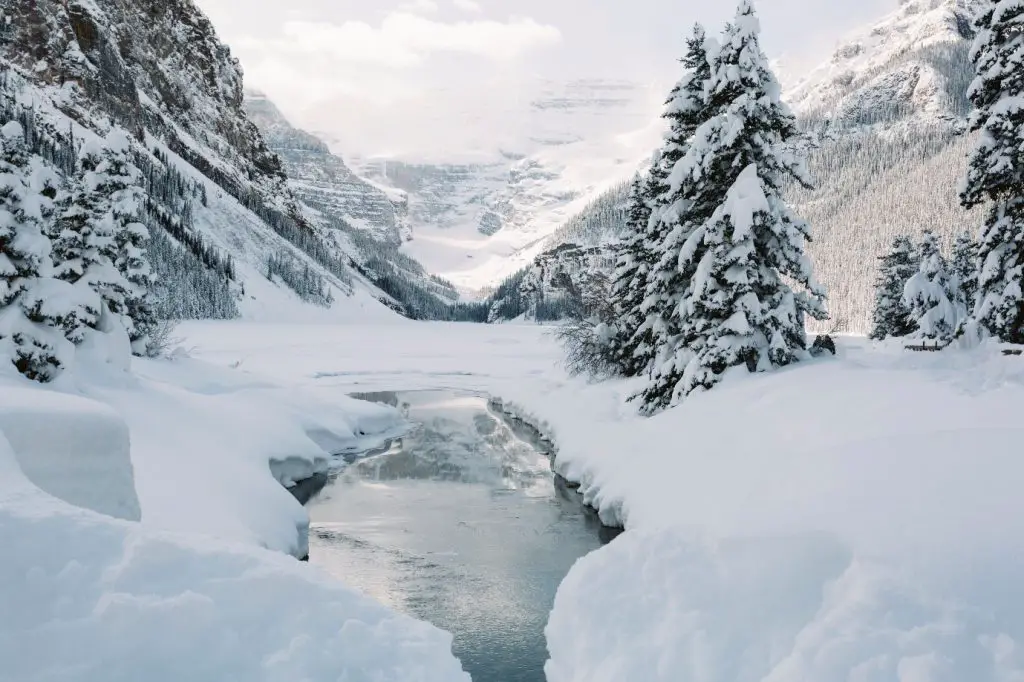
Before embarking on a snowmobile ride, especially long ones, check the weather forecast. You can plan your journey based on the same for staying safe. While traveling, it is best to keep an eye on weather updates. There are various smartphone applications and devices available that can provide you weather updates and notifications easily. If the weather is going to change suddenly, then you will be forewarned and can take shelter at someplace safe.
Invest In Emergency Gear and A First-Aid Kit
An important part of snowmobile safety is to be prepared for all sorts of situations. There may be cases wherein you or someone else gets injured. A first-aid kit is an essential item for such scenarios. The kit generally includes disinfecting wipes, gauzes, adhesive tape, and bandages, among other items. They can assist in treating small injuries and providing first aid to people. You can keep them in the storage compartment of your snowmobile.
In addition to a first-aid kit, you can also invest in an emergency kit. It includes all the items that can help you survive in the wild until help arrives. An emergency kit will have a flashlight, compass, map, thermal blanket, water, snacks, knife, whistle, flares, an avalanche probe, and waterproof matches. These items will be handy in case you are caught up in bad weather or have to spend the night outdoors.
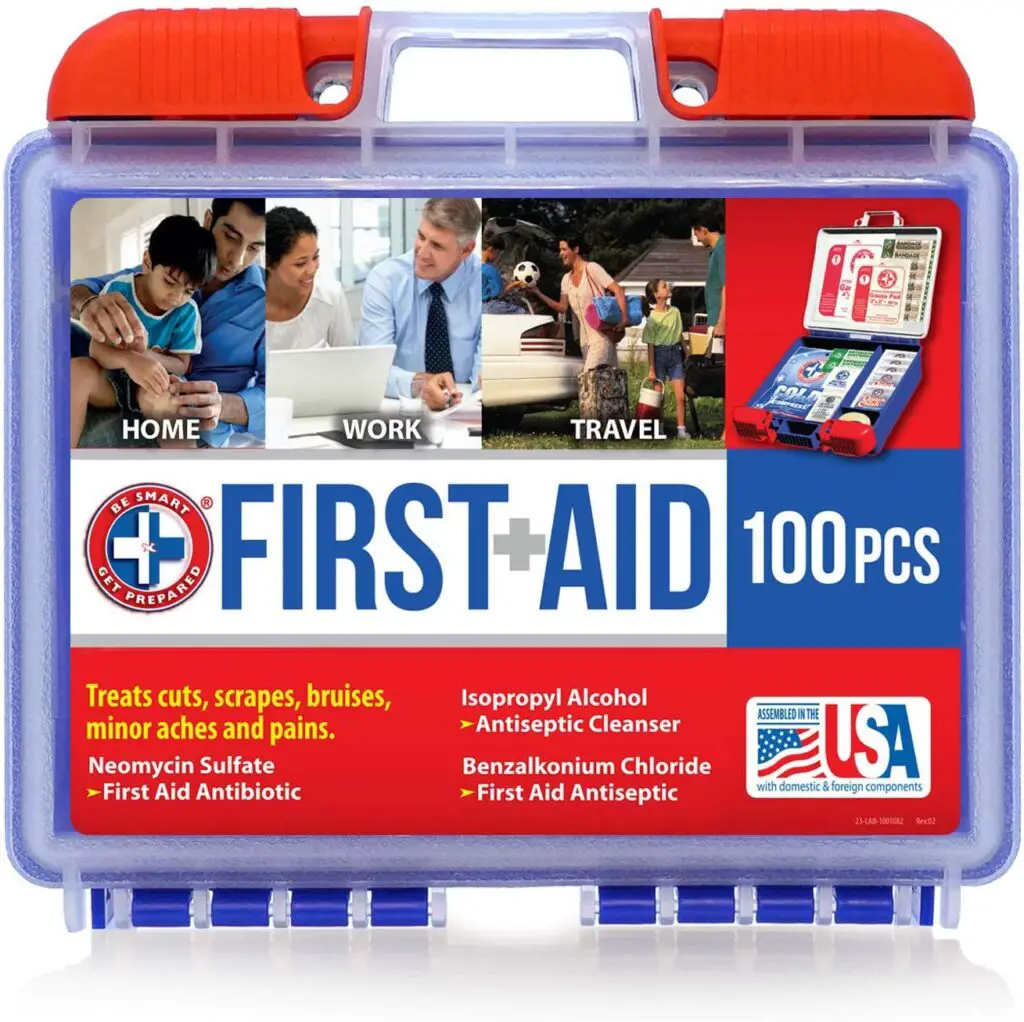
Keep A Repair Kit
Snowmobiles are machines and they can breakdown unexpectedly. One of their parts may malfunction or stop working and must be repaired. A repair kit is a great snowmobile safety item to have in such situations, especially for the riders who have to travel long distances or are touring. They will contain tools and items for repairing the snowmobile, including duct tape, spare belt, flashlight, tow rope, spark plugs, wrenches, and a pry bar.
Riders must also familiarize themselves with the workings of a snowmobile and the basic tools. They should know how to identify common issues and perform repairs in case of emergencies. It can be handy in case their sled breaks down in the middle of nowhere. Snowmobile riders must at least have a shovel and a towing rope so that they can free their snowmobile if it gets stuck in the snow. You can also keep an extra can of fuel, which can be helpful in case you are running low on gas.
Travel In Groups
Traveling with someone else can boost your snowmobile safety. Whenever possible, travel by snowmobiles in groups instead of going alone, especially on long journeys. At the very least, you can take a friend or companion with you. The person can be helpful in case your snowmobile gets stuck or breaks down, or you get injured. Their snowmobile can assist in freeing or towing your snowmobile as well. Also, discuss your planned route or itinerary with family or friends along with the approximate time that it may take to reach there. It can help them to ascertain whether you have reached your destination as per the schedule or are overdue and may need assistance.
Supervise Youth And Children
If your children ride a snowmobile, then you must always supervise them. Children can often get carried away in fun and may end up in an unfavorable situation. They are not strong enough to handle even youth snowmobiles (in case it gets stuck) due to the high strength and stamina required. There is also a risk of the snowmobile getting overturned. If you have kids riding on snowmobiles in your group, ensure that an adult leads the way while another adult follows them at the end.
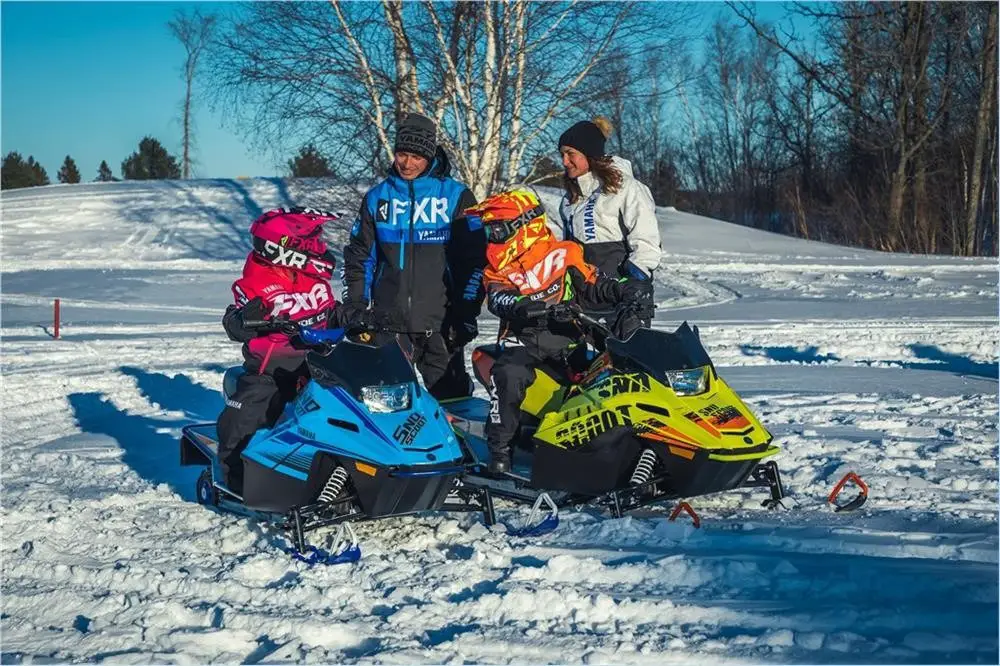
The most important facet of snowmobile safety is being alert and watchful. Keep your eyes on the road and watch for obstacles. Give proper signals (indicators or manually) before turning or stopping. Don’t panic in case of emergencies and follow your training. And above all, enjoy your snowmobile ride and don’t consider it as a competition.
Leave a Reply